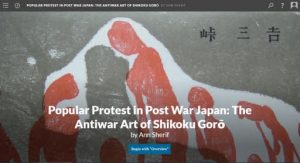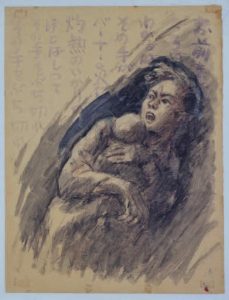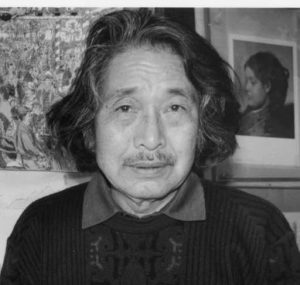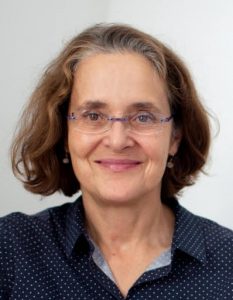US professor starts English website to introduce artwork and activities of Goro Shikoku, anti-war and anti-nuclear artist
Nov. 2, 2020
by Miho Kuwajima, Staff Writer
Ann Sherif, a professor at Oberlin College in the U.S. state of Ohio, has initiated a website in English to display the artwork and peace activities of the Japanese painter Goro Shikoku (1924–2014). The website conveys Mr. Shikoku’s history of artistic activities, such as paintings and poetry, through which he continued communicating to the world his anti-war and anti-nuclear messages.
The website, Popular Protest in Post War Japan: The Antiwar Art of Shikoku Gorō, covers his artwork created from 1949, when Japan was still occupied by U.S. and other Allied forces, until the 1990s. The site focuses on three publications, for which Mr. Shikoku illustrated the covers: Atom Bomb Poetry Collection (published in 1951) by poet Sankichi Toge; The Angry Jizo, a picture book (1979); and Hiroshima Sketches (1985).
The site describes the cover art of the Atom Bomb Poetry Collection, featuring orange-tinged people, as “a striking cover that evokes the human cost of war, but employs an abstract visual vocabulary & palette resonant with mid-20th century viewers.” It explains how the activities involving creative expression were undertaken under severe controls placed on freedom of speech around the time of the Korean War period (1950 through 1953).
Street posters are also exhibited on the website, complete with detailed descriptions. Such posters, which combine paintings with poems, would be pasted, guerrilla-like, to walls on the street. Mr. Shikoku created the posters after joining the group Our Poems Circle, which was formed by Mr. Toge and other poets. Five such posters, including one featuring a woman hugging a baby in her arms as she flees desperately, are displayed on the site.
With a specialty in Japanese literature, Ms. Sherif started research into A-bomb literature about ten years ago. She began to take increased interest in the works of Mr. Shikoku, a veteran of World War II who experienced detention in a Siberian labor camp and the death of his younger brother in the atomic bombing. Ms. Sherif visited Hiroshima frequently and collected materials associated with Mr. Shikoku by deepening ties to members of the Association of Preservation Data on Hiroshima Literature, a local citizen’s group located in Hiroshima’s Naka Ward.
Amid the current situation in the United States, a country that is experiencing a deepening divide among citizens as the presidential election approaches, Ms. Sherif said she felt that democracy in her country had greatly wavered. “I want young people in the United States to get to know the works created by Mr. Shikoku. They could gain a lot of insight from his history of continued protest through artwork and earnest exploration of democracy.”
Hikaru Shikoku, 64, Goro’s oldest son who lives in Suita, Osaka Prefecture, and others provided Ms. Sherif with about 50 items of image data and other materials. Sharing his expectations, Hikaru said, “My father hoped that painting was utilized as one way to make anti-nuclear appeals. I believe his artwork can serve as peace education materials for a diversity of different cultures.”
The website URL is: http://scalar.oberlincollegelibrary.org/shikoku/index .
(Originally published on November 2, 2020)
Ann Sherif, a professor at Oberlin College in the U.S. state of Ohio, has initiated a website in English to display the artwork and peace activities of the Japanese painter Goro Shikoku (1924–2014). The website conveys Mr. Shikoku’s history of artistic activities, such as paintings and poetry, through which he continued communicating to the world his anti-war and anti-nuclear messages.
The website, Popular Protest in Post War Japan: The Antiwar Art of Shikoku Gorō, covers his artwork created from 1949, when Japan was still occupied by U.S. and other Allied forces, until the 1990s. The site focuses on three publications, for which Mr. Shikoku illustrated the covers: Atom Bomb Poetry Collection (published in 1951) by poet Sankichi Toge; The Angry Jizo, a picture book (1979); and Hiroshima Sketches (1985).
The site describes the cover art of the Atom Bomb Poetry Collection, featuring orange-tinged people, as “a striking cover that evokes the human cost of war, but employs an abstract visual vocabulary & palette resonant with mid-20th century viewers.” It explains how the activities involving creative expression were undertaken under severe controls placed on freedom of speech around the time of the Korean War period (1950 through 1953).
Street posters are also exhibited on the website, complete with detailed descriptions. Such posters, which combine paintings with poems, would be pasted, guerrilla-like, to walls on the street. Mr. Shikoku created the posters after joining the group Our Poems Circle, which was formed by Mr. Toge and other poets. Five such posters, including one featuring a woman hugging a baby in her arms as she flees desperately, are displayed on the site.
With a specialty in Japanese literature, Ms. Sherif started research into A-bomb literature about ten years ago. She began to take increased interest in the works of Mr. Shikoku, a veteran of World War II who experienced detention in a Siberian labor camp and the death of his younger brother in the atomic bombing. Ms. Sherif visited Hiroshima frequently and collected materials associated with Mr. Shikoku by deepening ties to members of the Association of Preservation Data on Hiroshima Literature, a local citizen’s group located in Hiroshima’s Naka Ward.
Amid the current situation in the United States, a country that is experiencing a deepening divide among citizens as the presidential election approaches, Ms. Sherif said she felt that democracy in her country had greatly wavered. “I want young people in the United States to get to know the works created by Mr. Shikoku. They could gain a lot of insight from his history of continued protest through artwork and earnest exploration of democracy.”
Hikaru Shikoku, 64, Goro’s oldest son who lives in Suita, Osaka Prefecture, and others provided Ms. Sherif with about 50 items of image data and other materials. Sharing his expectations, Hikaru said, “My father hoped that painting was utilized as one way to make anti-nuclear appeals. I believe his artwork can serve as peace education materials for a diversity of different cultures.”
The website URL is: http://scalar.oberlincollegelibrary.org/shikoku/index .
(Originally published on November 2, 2020)











